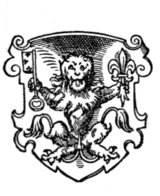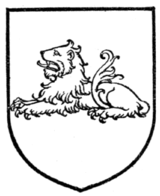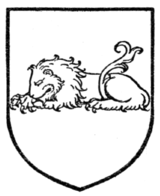but the whole body is turned to face the spectator, the forepaws resting upon the ground in front of its body. Ugly as this position is, and impossible as it might seem, it certainly is to be found in some of the early rolls.
Lion sejant erect affronté (Fig. 294).—This position is by no means unusual in Scotland. A lion sejant erect and affronté, &c., is the Royal crest of Scotland, and it will also be found in the arms of Lyon Office.
A good representation of the lion sejant affronté and erect is shown in Fig. 310, which is taken from Jost Amman's Wappen und Stammbuch (1589). It represents the arms of the celebrated Lansquenet Captain Sebastian Schärtlin (Schertel) von Burtenbach ["Gules, a lion sejant affronté erect, double-queued, holding in its dexter paw a key argent and in its sinister a fleur-de-lis"]. His victorious assault on Rome in 1527, and his striking successes against France in 1532, are strikingly typified in these arms, which were granted in 1534.
Lion Couchant.—In this position the lion is represented lying down, but the head is erect and alert (Fig. 311).
Lion dormant.—A lion dormant is in much the same position as a lion couchant, except that the eyes are closed, and the head rests upon the extended forepaws (Fig. 312). Lions dormant are seldom met with, but they occur in the arms of Lloyd, of Stockton Hall, near York.
Lion morné.—This is a lion without teeth and claws, but no instance of the use of the term would appear to exist in British armory. Woodward mentions amongst other Continental examples the arms of the old French family of De Mornay ["Fascé d'argent et de gueules au lion morné de sable, couronné d'or brochant sur le tout"].
Lions as supporters.—Refer to the chapter on Supporters.
Winged lion.—The winged lion—usually known as the lion of St. Mark—is not infrequently met with. It will be found both passant



